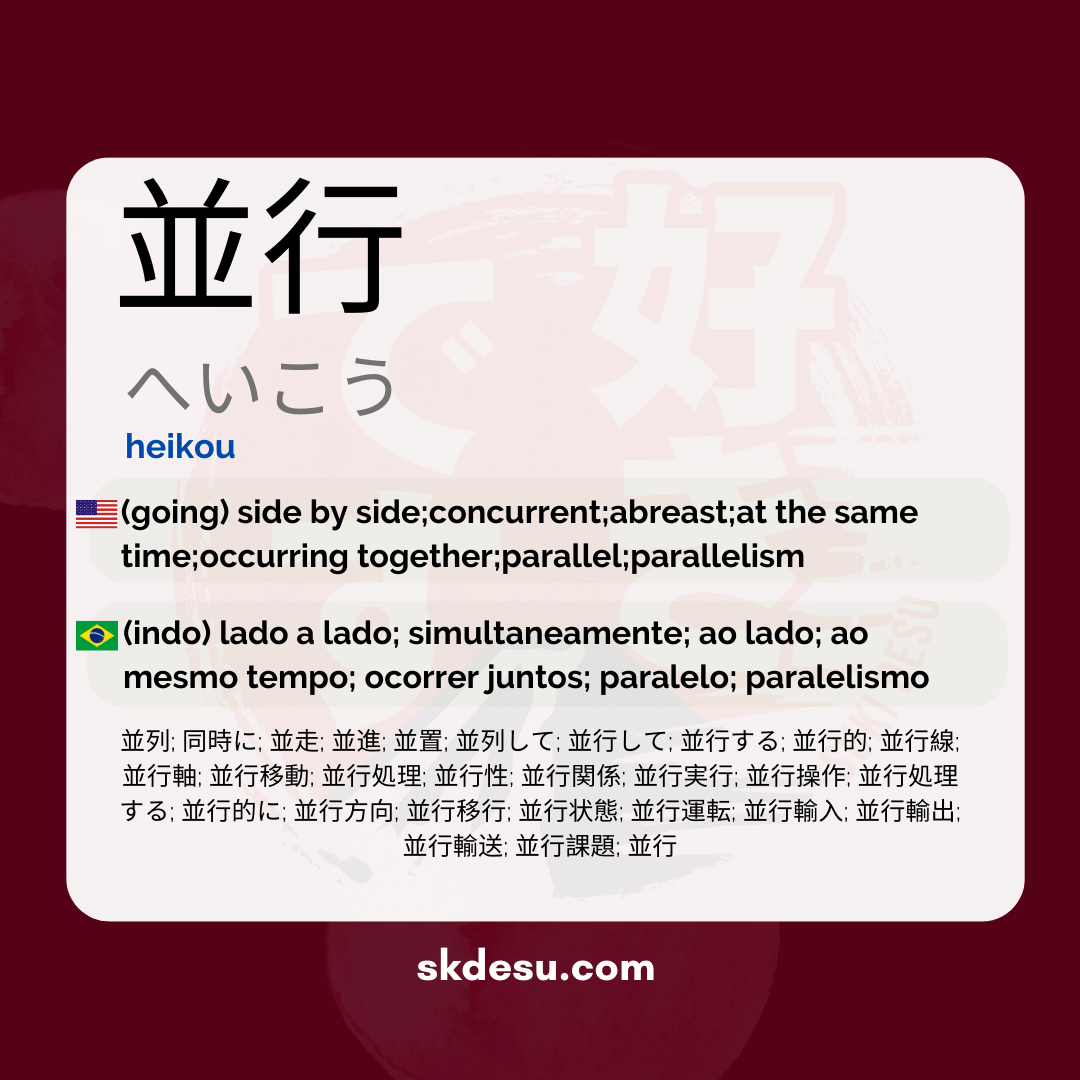Translation and Meaning of: 並行 - heikou
The Japanese word 「並行」 (heikou) has a rich etymology that dates back to ancient times. 「並」 (hei) means "side by side" or "parallel," and 「行」 (kou) refers to "to go" or "line." Together, these words form the term 「並行」, which denotes the idea of "parallelism" or "simultaneity." This combination reflects the Japanese language's ability to express complex concepts through the merging of simple meanings, providing a clear perspective on actions or conditions that occur simultaneously or in parallel.
In everyday use, 「並行」 (heikou) is often employed to describe situations where two or more activities or events are happening simultaneously. For example, one might say that someone is working on two different projects in parallel. Extensively, the expression is also useful in technical contexts to explain phenomena occurring in parallel, such as train lines running side by side or processes in computing systems.
The origin of the term 「並行」 highlights the visual and physical aspect of the Japanese language, where arrangement and alignment have a significant impact. Eastern cultures, particularly Japanese, often use visual analogies to describe abstract concepts, and 「並行」 precisely illustrates this tendency. The idea of walking side by side or performing multiple tasks simultaneously resonates with the importance placed on balance and efficiency in Japanese culture.
Variations and Use in Different Contexts
The term 「並行」 is also found in various ways to describe parallel and simultaneous acts in the Japanese language. Something interesting is how this word can be adapted to different contexts, from casual to technical. In more informal contexts, such as in a daily conversation, 「並行」 can be used to describe the act of managing multiple personal responsibilities at the same time. In contrast, in scientific or engineering contexts, the term can illustrate the parallel operation of systems or processes.
Vocabulary
Expand your vocabulary with related words:
Synonyms and similar words
- 並列 (へいれつ) - Parallel arrangement; parallel sequence relationship.
- 並行 (へいこう) - Advance in parallel; simultaneity in similar direction.
- 並走 (へいそう) - Run side by side; parallel movement.
- 並進 (へいしん) - Progress in parallel lines; coherent movement.
- 並置 (へいち) - Side by side placement; parallel arrangement of objects.
- 並列して (へいれつして) - Arranged parallel; in parallel with each other.
- 並行して (へいこうして) - Operating in parallel; simultaneously.
- 並行する (へいこうする) - Carry out in parallel; do simultaneously.
- 並行的 (へいこうてき) - In parallel; related to parallel functioning.
- 並行線 (へいこうせん) - Parallel lines; lines that never meet.
- 並行軸 (へいこうじく) - Parallel axes; reference in parallel movement.
- 並行移動 (へいこういどう) - Parallel movement; simultaneous displacement.
- 並行処理 (へいこうしょり) - Parallel processing; simultaneous task execution.
- 並行性 (へいこうせい) - Parallelism; the nature of being parallel.
- 並行関係 (へいこうかんけい) - Parallel relationships; simultaneous connections between elements.
- 並行実行 (へいこうじっこう) - Parallel execution; carrying out activities at the same time.
- 並行操作 (へいこうそうさ) - Parallel operation; simultaneous manipulation.
- 並行処理する (へいこうしょりする) - Perform parallel processing; execute tasks simultaneously.
- 並行的に (へいこうてきに) - In a parallel way; in a parallel format.
- 並行方向 (へいこうほうこう) - Parallel direction; equidistant orientation.
- 並行状態 (へいこうじょうたい) - Parallel state; condition of simultaneous operation.
- 並行運転 (へいこううんてん) - Parallel operation; simultaneous functioning of vehicles.
- 並行輸入 (へいこうゆにゅう) - Parallel import; simultaneous acquisition of products from different sources.
- 並行輸出 (へいこうゆしゅつ) - Parallel export; simultaneous shipment of goods.
- 並行輸送 (へいこうゆそう) - Parallel transport; simultaneous movement of goods.
- 並行課題 (へいこうかだい) - Parallel tasks; problems to be solved simultaneously.
Related words
heikou
(indo) side by side; simultaneously; beside; at the same time; occur together; parallel; parallelism
narabini
I'm sorry, but I need a text or string to translate from Portuguese to English. Please provide the content you'd like me to work on.
Romaji: heikou
Kana: へいこう
Type: noun
L: jlpt-n2, jlpt-n1
Translation / Meaning: (indo) side by side; simultaneously; beside; at the same time; occur together; parallel; parallelism
Meaning in English: (going) side by side;concurrent;abreast;at the same time;occurring together;parallel;parallelism
Definition: Progressing in the same direction and with the same purpose.
Quick Access
- Vocabulary
- Writing
- Sentences
How to Write in Japanese - (並行) heikou
See below a step-by-step guide on how to write the word by hand in Japanese. (並行) heikou:
Example Sentences - (並行) heikou
See below some example sentences:
Heikou shite aruku
Walk in parallel.
Walk in parallel.
- 並行して - means "together" or "parallel".
- 歩く - means "to walk" or "to stroll".
Other Words of this Type: noun
See other words from our dictionary that are also: noun

